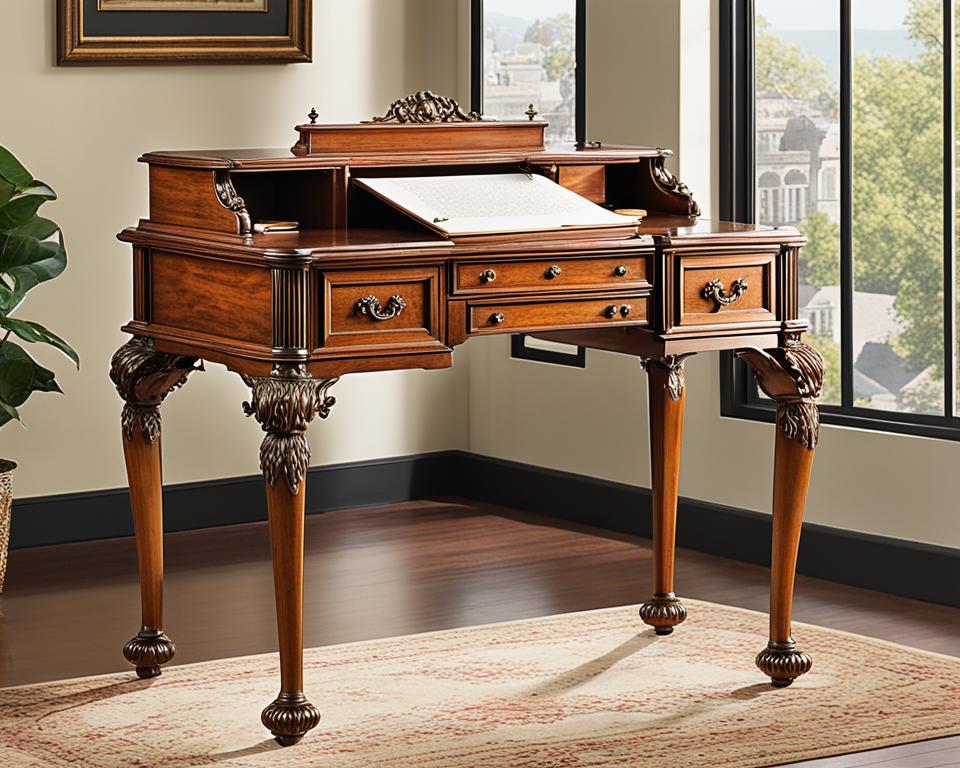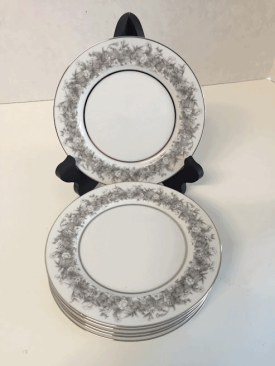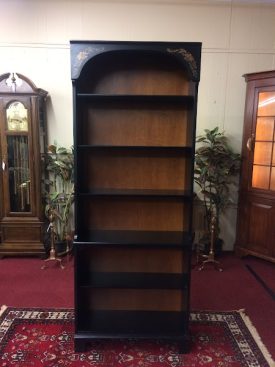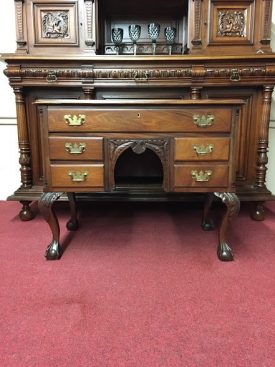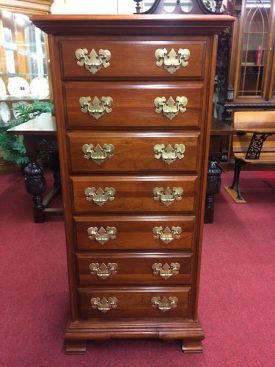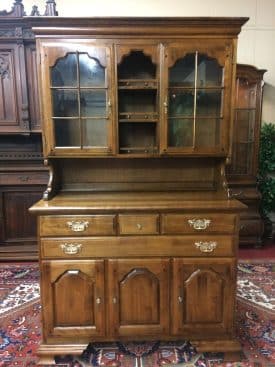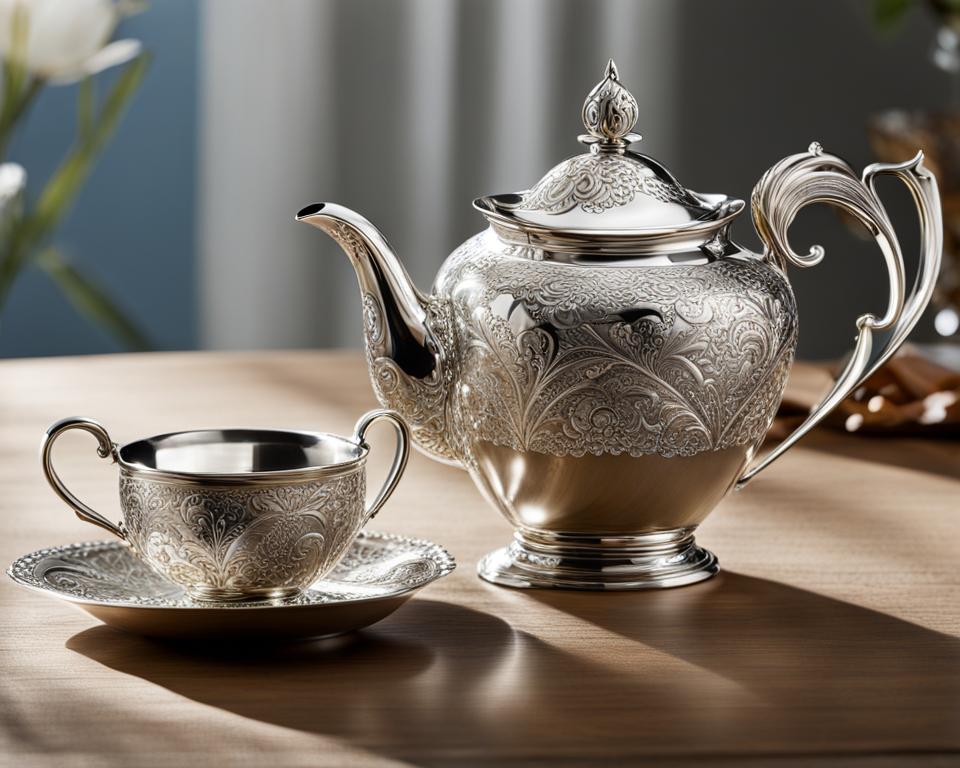Antique Davenport Desks are the epitome of vintage charm and elegance. With a rich history dating back to the 18th century, these desks have captivated collectors and enthusiasts worldwide. Originally known as the Bureau in France, these fall-fronted cabinets evolved over time, giving rise to various styles and designs. From Georgian to Victorian to Edwardian, each period brought forth its own unique interpretation of the antique writing desk.
Mainly used for writing and dressing, Georgian desks were prominent in the 18th century. The Victorian era saw an explosion of creativity, resulting in a wide range of designs and a focus on usability and quality. Edwardian desks, built at the turn of the 20th century, incorporated new woodworking technology, showcasing exquisite craftsmanship.
Antique Davenport Desks come in a plethora of styles, including the Bureau, Bonheur Du Jour, Carlton House, Cylinder desk, Dickens desk, Knee-hole desk, Kidney desk, Library desk, Partners desk, Pedestal desk, and Roll-top desk. Each style features unique elements and decorative details that add to their allure.
Whether you’re a history enthusiast, a collector, or simply someone who appreciates the beauty of vintage furniture, an Antique Davenport Desk is a must-have for any study or office. Its timeless appeal and exquisite craftsmanship make it a statement piece that adds a touch of elegance to any space.
Key Takeaways:
- An Antique Davenport Desk offers vintage charm and elegance for any study or office.
- These desks originated in France as the fall-fronted Bureau and evolved with different styles over the centuries.
- Georgian desks were popular in the 18th century, while Victorian and Edwardian desks showcased creativity and innovative woodworking techniques.
- Antique Davenport Desks come in various styles like Bureau, Bonheur Du Jour, Carlton House, Cylinder desk, Dickens desk, Knee-hole desk, Kidney desk, Library desk, Partners desk, Pedestal desk, and Roll-top desk.
- They are highly sought after for their vintage charm, making them a perfect addition to any study or office.
The History of Antique Desks
Antique desks have a long and fascinating history that spans several centuries. From the earliest forms of writing furniture to the intricate designs of different periods, antique desks have evolved to become sought-after pieces of antique furniture that combine beauty and functionality.
One of the earliest forms of antique desk is the Bureau, which emerged in France around 1650. This fall-fronted cabinet featured gate legs for support and provided a convenient writing surface. Over time, the gate leg supports were replaced by sliding loppers, enhancing the stability and usability of the desk.
In the 18th century, Georgian desks became popular. These desks were not only used for writing but also served as dressing tables. Georgian desks were crafted with attention to detail and often featured ornate designs and decorative elements.
During Queen Victoria’s reign in the 19th century, Victorian desks were built with new designs and shapes. These desks catered to the changing needs of the time, offering functionality and style. Victorian desks came in various designs, including the iconic Kidney shape, bow front, and Cylinder front.
As the 20th century approached, Edwardian desks incorporated new woodworking techniques. Cabinetmakers had access to woodworking machines that allowed for the creation of intricate designs and details. Edwardian desks often featured blind fretwork or intricate inlays, showcasing elegance and sophistication.
To summarize the history of antique desks:
- The Bureau emerged in France in the 17th century, featuring a fall-fronted cabinet with gate legs for support.
- Georgian desks gained popularity in the 18th century, serving dual purposes as writing and dressing tables. These desks were known for their ornate designs and decorative elements.
- Victorian desks were built during Queen Victoria’s reign in the 19th century, offering new designs and shapes to cater to changing needs. The Kidney shape, bow front, and Cylinder front were popular designs during this period.
- Edwardian desks, made at the turn of the 20th century, showcased new woodworking techniques and attention to detail with features like blind fretwork and intricate inlays.
Throughout history, antique desks have transformed in design, style, and functionality. Each period has left its mark on these timeless pieces of furniture, making them valuable and cherished by antique enthusiasts and collectors.
The Different Styles of Antique Desks
Antique desks offer a wide range of styles, each with its own unique characteristics and features. Whether you’re looking for a vintage secretary desk or a Victorian writing desk, there is an antique desk to suit every taste and style. Let’s explore some of the most popular styles:
The Bureau
The Bureau is an early writing desk that features a sloping fall-front, providing a convenient writing surface when opened. It often has multiple drawers and compartments for storage.
The Bonheur Du Jour
The Bonheur Du Jour is a fine-looking desk known for its cross banding and decorative elements. It offers a compact and elegant design, perfect for smaller spaces.
The Carlton House
Named after the Prince of Wales’ residence, the Carlton House desk is characterized by its fitted drawers and small cupboards. It combines functionality with a touch of sophistication.
The Cylinder Desk
The Cylinder desk features a unique cylinder-shaped front that opens to reveal a writing surface and pigeon holes for storage. It showcases both style and practicality.
The Dickens Desk
The Dickens desk is inspired by the famous Victorian author, Charles Dickens. It typically features a simple design with multiple drawers and a spacious writing area.
The Knee-Hole Desk
The Knee-Hole desk is designed with a central hole or space that allows for easy sitting and working. It’s a popular choice for those looking for comfort and functionality.
The Kidney Desk
The Kidney desk is known for its curved shape, which adds an elegant touch to any study or office. It offers a generous writing area and often includes drawers for storage.
The Library Desk
The Library desk is a statement piece with a leather top, perfect for a distinguished study or library. It features a classic design and ample storage space.
The Partners Desk
The Partners desk is a larger desk with drawers or cupboards on both sides, making it ideal for shared workspaces or home offices. It provides ample space for two people to work comfortably.
The Pedestal Desk
The Pedestal desk is a free-standing desk with a tooled leather top and two pedestals for support. It offers a sturdy and spacious work surface, often with ample storage options.
The Roll-Top Desk
The Roll-Top desk features a slatted front that can be opened and closed, providing privacy and security for your workspace. It combines functionality with a classic design.
These are just a few examples of the different styles of antique desks available. Each style has its own unique appeal and can add a touch of vintage charm to any study or office. Whether you prefer the timeless elegance of a Victorian desk or the classic sophistication of a Bureau, antique desks are a perfect choice for those seeking both style and functionality.
Next, we’ll explore the history of Georgian desks and their elegant and functional designs.
Georgian Desks: Elegant and Functional
In the 18th century, Georgian desks played a significant role in the lives of the affluent class. These desks, built between 1714 and the Regency period of 1830, served as both writing and dressing tables, often adorning luxurious rooms. Georgian desks came in various forms, including pedestal desks that were originally used for dressing. As the Georgian era progressed, larger desks called Partners desks emerged. These desks featured working drawers and cupboards on both sides, making them ideal for high-ranking professionals such as bankers and solicitors. Crafted from exquisite timbers like Cuban Mahogany, Georgian desks exuded the essence of country charm and character.
The Georgian era gave rise to elegant and functional desks that perfectly fit the aristocratic lifestyle. With their exquisite craftsmanship and choice of premium materials, Georgian desks became cherished pieces of antique furniture.
The Appeal of Georgian Desks
Georgian desks captivate antique enthusiasts and interior designers for various reasons:
- Elegant Design: Georgian desks boast timeless designs that seamlessly blend sophistication and functionality. The attention to detail and exquisite craftsmanship mirror the refined taste of the period.
- Superior Materials: Crafted from finest-quality timbers such as Cuban Mahogany, Georgian desks exhibit exceptional durability and showcase the natural beauty of the wood grain.
- Functional Features: Georgian desks were designed to cater to the needs of the elite. With ample storage space, including drawers and cupboards, they effortlessly accommodated various writing and dressing essentials.
A Closer Look at Georgian Pedestal Desks
Georgian pedestal desks stand out as one of the prominent designs of the era. Originally conceived as dressing tables, these desks evolved to become functional pieces for luxurious study and office spaces. The distinguishing features of Georgian pedestal desks include:
- Graceful Silhouette: Georgian pedestal desks exhibit a refined silhouette with elegant curves and proportions. The graceful lines exude an air of sophistication and add a touch of class to any interior.
- Practicality: With their spacious work surfaces and convenient storage, pedestal desks offer ample room for productivity. The drawers and cupboards provide organized spaces for documents, stationery, and other essentials.
- Timeless Beauty: These desks showcase the timeless beauty of Georgian design. The combination of rich wood tones, intricate detailing, and exquisite hardware make them a focal point in any space.
| Pros | Cons |
|---|---|
| Exudes timeless elegance | May command a higher price due to demand and craftsmanship |
| Offers ample storage space | Large size may not suit smaller spaces |
| Superior craftsmanship and quality | Requires proper maintenance to preserve its condition |
| Serves as a functional and stylish centerpiece in any study or office | May be challenging to find an authentic Georgian desk in excellent condition |
Georgian desks are prized possessions, drawing admiration for their elegant design, exceptional craftsmanship, and functional features. These desks not only serve as functional workspaces but also as exquisite works of art and a testament to the rich history of antique furniture.
Victorian Desks: Style and Functionality
Victorian desks, crafted during Queen Victoria’s reign from 1837 to 1901, epitomized the era’s new industrial wealth. These desks were designed for use in offices, libraries, and factories, showcasing a diverse range of designs and styles. Victorian desks combined both functionality and aesthetic appeal, making them a popular choice for discerning individuals.
Victorian desk designs varied significantly, catering to different tastes and needs. Some of the most sought-after designs included the Kidney shape, bow front, and Cylinder front. The Kidney shape, with its gracefully curved surface, was particularly coveted for its elegance and sophistication. The bow front design, featuring a gently curved front surface, added a touch of refinement to any room. The Cylinder front, with its cylinder-shaped opening mechanism, offered both practicality and charm.
Victorian desks stood out not only for their style but also for their attention to detail and quality. They often featured a bank of drawers or cupboards, providing ample storage space for documents and personal effects. The handles used were of high quality and added a touch of sophistication to the overall design.
Towards the late 19th century, Neo classical designs emerged, introducing exotic woods like Rosewood and Satinwood. These lighter wood finishes suited the luxurious homes of the higher classes, bringing an air of opulence and grandeur. Victorian desks became a statement piece, not only for their functionality but also for their intricate craftsmanship and decorative elements.
| Feature | Description |
|---|---|
| Designs | Kidney shape, bow front, Cylinder front |
| Drawers and Cupboards | Ample storage space for documents and personal effects |
| Handles | High-quality handles finished to perfection |
| Materials | Rosewood, Satinwood, and other exotic woods |
Neo classical Designs in Victorian Desks
“The introduction of Neo classical designs during the late 19th century marked a significant shift in Victorian desk aesthetics. These designs showcased exotic wood finishes and sophisticated detailing, bringing a sense of elegance and luxury to the desks.”
Victorian desks continue to be cherished as magnificent examples of period furniture. Their exquisite style, functionality, and superior craftsmanship make them highly sought after by antique collectors and enthusiasts.
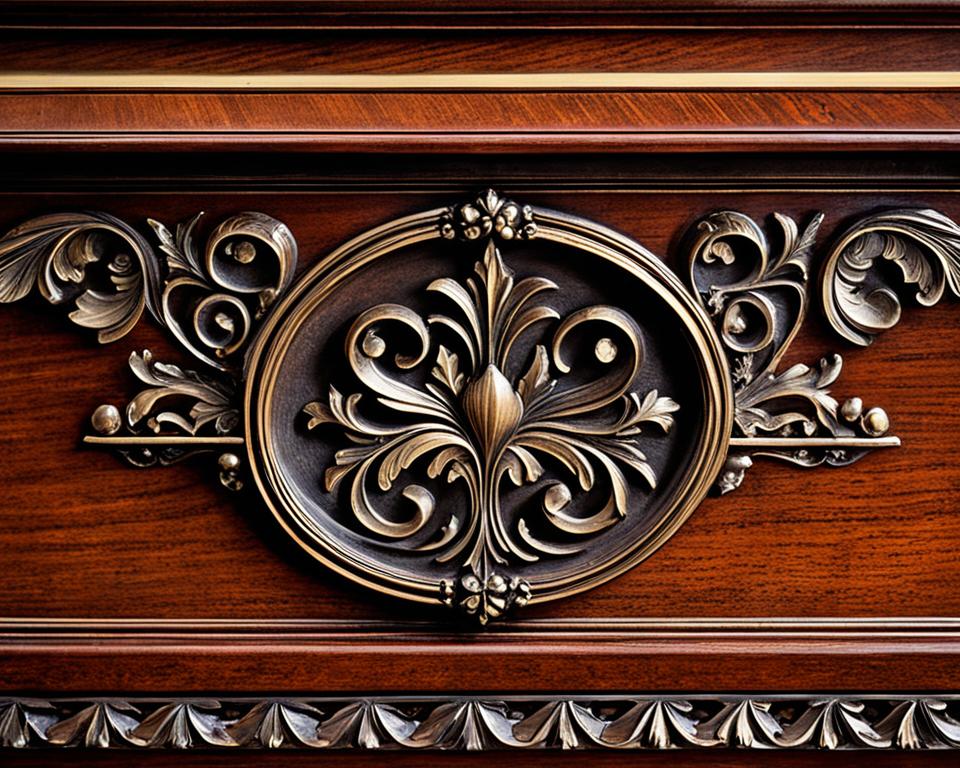
Edwardian Desks: New Developments and Elegance
The Edwardian era, spanning from 1901 to 1910, brought about significant advancements in furniture design. During this time, cabinet makers had access to new woodworking machines, allowing for the creation of innovative designs and ideas. Edwardian desks, known for their elegance and attention to detail, incorporated elements from earlier styles, such as blind fretwork and intricate inlays.
One notable feature of Edwardian desks is the Tambour front, which became popular during this period. The Tambour front is a slatted roll top that can be easily opened and closed, providing a secure way to store important documents and paperwork. This feature added both functionality and a touch of sophistication to Edwardian desks.
The craftsmanship of Edwardian desks was unparalleled, with hand-carved embellishments and high-quality finishes. These desks were made with meticulous attention to detail, exemplifying the refined aesthetics of the era. Whether adorned with delicate floral motifs or showcasing rich wood grain patterns, Edwardian desks were truly works of art.
Edwardian desks were crafted with precision and care, combining functionality with exquisite design elements. These desks were the epitome of elegance, adding a touch of sophistication to any study or office space.
Edwardian desks continue to be highly sought after by antique furniture enthusiasts and collectors. Their timeless appeal and unique design make them a valuable addition to any vintage-inspired interior. Whether you’re a history enthusiast, a lover of antique furniture, or simply appreciate the beauty of bygone eras, an Edwardian desk is sure to captivate your attention.
Antique Roll-top Desks: Timeless Appeal
Antique roll-top desks have a timeless appeal and are highly sought after for their functionality and style. These exquisite pieces of antique furniture feature a unique design element – a slatted front that can be rolled up and down, revealing a convenient writing surface and ample storage compartments.
Made from durable materials such as Oak or Walnut, roll-top desks were often supported by pedestals or twin pedestals, adding stability and elegance to their overall structure. The interiors of these desks are thoughtfully designed with small drawers and pigeon holes, allowing for efficient organization of papers and supplies.
The tambour fronts of roll-top desks can come in two elegant shapes – D-shaped or S-shaped, which adds a touch of sophistication to their appearance. These antique desks were particularly popular during the Edwardian period and continue to be highly coveted by antique collectors and enthusiasts today.
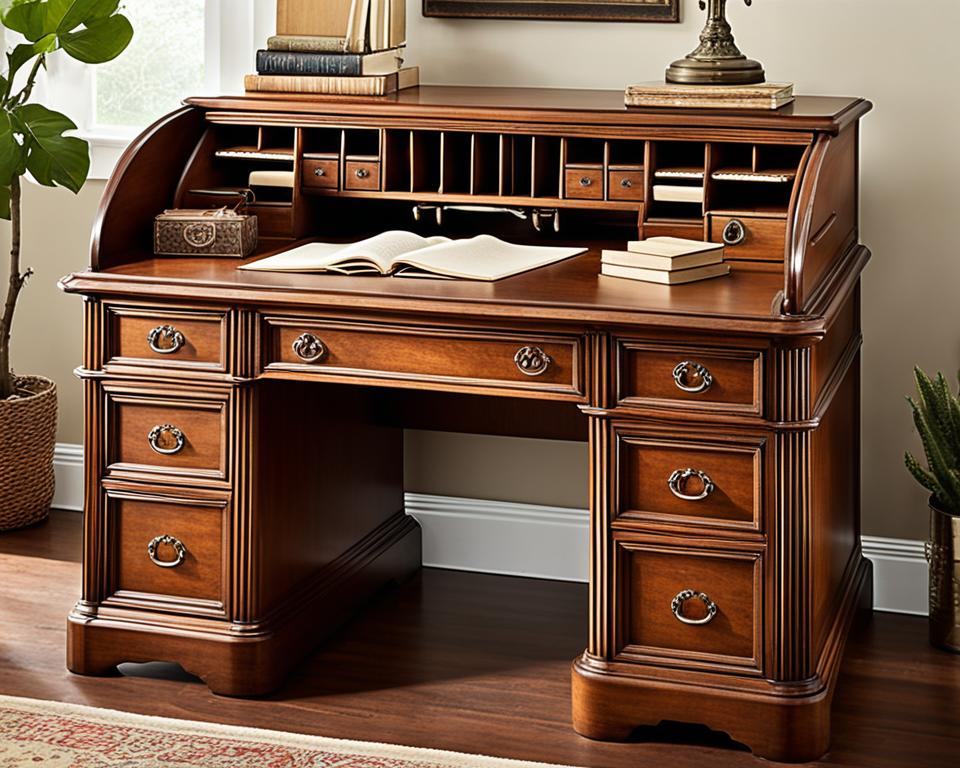
Benefits of Antique Roll-top Desks:
- Functional Design: The roll-top design provides a convenient way to hide away clutter and protect confidential documents.
- Ample Storage Space: With multiple drawers and compartments, these desks offer ample storage for papers, books, and office supplies.
- Timeless Aesthetic: Antique roll-top desks add a touch of vintage elegance and sophistication to any study or office space.
- Durable Craftsmanship: Built with meticulous attention to detail and high-quality materials, antique roll-top desks are known for their durability and longevity.
- Investment Value: Antique furniture, including roll-top desks, often retains or appreciates in value over time, making them a valuable investment.
| Features | Bureau | Bonheur Du Jour | Cylinder Desk |
|---|---|---|---|
| Front Design | Fall-front | Cross banding, decorative elements | Cylinder-shaped front |
| Storage Space | Drawer compartments, small cupboards | Drawers, small cupboards | Pigeon holes, drawers |
| Material | Wood | Wood | Wood |
| Intended Use | Writing and dressing | Writing | Writing and storage |
Notable Designs of Antique Roll-top Desks:
The Bureau: An early writing desk with a sloping fall-front.
The Bonheur Du Jour: A fine-looking desk with cross banding and decorative elements.
The Cylinder Desk: Features a unique cylinder-shaped front that opens to reveal a writing surface and pigeon holes for storage.
Antique roll-top desks are not only functional but also serve as statement pieces, adding a touch of vintage charm to any office or study. Their intricate craftsmanship and timeless appeal make them a worthwhile investment for antique furniture enthusiasts and collectors.
Antique Davenport Desks: A Unique and Practical Design
Antique Davenport desks are a testament to exquisite craftsmanship and unmatched practicality. First introduced in 1790, these unique desks were originally created for Captain Davenport, and they quickly gained popularity for their distinctive features and timeless charm. Perfectly blending form and function, Davenport desks are highly sought after by collectors and enthusiasts of antique furniture.
One of the defining characteristics of Davenport desks is their compact size. Designed to fit seamlessly into any space, these desks are ideal for those seeking a vintage writing desk without sacrificing valuable room space. The lift-up, sloping lid is a hallmark feature of Davenport desks, revealing a spacious writing surface and convenient storage space.
On one side of the desk, you’ll find working drawers, providing ample room for storing pens, papers, and other essentials. On the opposite side, you’ll find faux dummy drawer fronts, adding a touch of elegance and symmetry to the overall design. This careful attention to detail is a testament to the craftsmanship and thoughtfulness that went into creating these exquisite pieces of antique furniture.
The best examples of Davenport desks feature a “piano top” mechanism. When opened using a pulley system, the piano top reveals hidden compartments and small drawers, perfect for organizing stationery and other treasures. These intricate details not only showcase the ingenuity of the design but also add to the overall decorative appeal of the desk.
Decorative elements like glass inkwells and hinged fountain pen side drawers further enhance the vintage charm of Davenport desks. These exquisite details not only make these desks functional but also add a touch of elegance to any study or office space. Whether you’re a collector or someone who values both style and practicality, an antique Davenport desk is sure to make a statement in your home or workplace.
| Features of Antique Davenport Desks | Benefits |
|---|---|
| Faux dummy drawer fronts | Enhances the overall design and symmetry of the desk |
| Lift-up sloping lid | Reveals a spacious writing surface and hidden storage compartments |
| Working drawers | Provides convenient storage for pens, papers, and other essentials |
| Piano top mechanism | Unveils secret compartments and small drawers for stationery |
| Glass inkwells and hinged fountain pen side drawers | Adds decorative appeal and vintage charm |
Antique Davenport desks are not only functional but also serve as stunning pieces of art. Their unique design and exceptional craftsmanship make them highly desirable for those seeking a vintage writing desk that transforms any space into a place of elegance and sophistication. If you’re a connoisseur of antique furniture or simply appreciate the charm and practicality of vintage pieces, an antique Davenport desk could be the perfect addition to your collection or workspace.
Choosing the Perfect Antique Desk for Your Space
When it comes to selecting the ideal antique desk for your study or office, there are several important factors to consider. By carefully evaluating the style, size, materials, condition, and budget, you can find a vintage piece that perfectly complements your space.
Determine the Style and Design
First and foremost, identify the style and design that best aligns with your aesthetic preferences and the overall theme of your study or office. Consider the period or era of antique furniture that resonates with you. Whether you prefer the elegant Georgian desks or the ornate Victorian styles, narrowing down your options based on design will help guide your search.
Consider the Size and Dimensions
Measure your available space to determine the appropriate size and dimensions for your antique desk. Antique desks come in various sizes, ranging from compact writing desks to larger executive desks. Consider the dimensions not only in terms of length and width but also height to ensure it fits comfortably in your space.
Evaluate the Materials and Condition
Pay close attention to the materials used in crafting the antique desk. Look for desks made from high-quality woods like Mahogany or Oak, known for their durability and elegance. Inspect the desk for any signs of damage or restoration, ensuring its structural integrity and authentic vintage appeal.
Account for Your Budget
Determine your budget for the antique desk. Prices can vary depending on factors such as age, condition, rarity, and craftsmanship. It’s important to establish a budget range to help narrow down your search and ensure you find a desk that meets both your style preferences and financial capabilities.
Consider Specific Features and Functions
Think about the specific features or functions you require from your antique desk. Do you need ample storage with drawers or compartments? Would a drop-front desk better suit your needs? Assess your workflow and storage requirements to find a desk that provides practical functionality in addition to its vintage charm.
By taking these factors into consideration, you can make an informed decision when choosing the perfect antique desk for your space. Remember that antique desks add a touch of history and character to any study or office, making them a timeless investment that combines vintage allure with practicality.
Conclusion
Antique desks, such as the Davenport desk, offer a unique blend of vintage charm and timeless elegance. These exquisite pieces of antique furniture are crafted with expert craftsmanship and attention to detail, making them highly coveted by antique collectors and enthusiasts. From Georgian to Victorian to Edwardian designs, there are various styles to choose from, each with its own distinctive features.
Whether you’re looking for a small writing desk or a larger executive desk, antique desks can add a touch of nostalgia and character to any study or office space. The vintage study furniture not only provides a functional workspace, but it also serves as a statement piece that reflects your taste and style.
When choosing the perfect antique desk, it’s important to consider factors such as style, size, materials, and budget. Antique desks come in different sizes and are made from high-quality woods like Mahogany or Oak. By carefully considering these factors, you can find the perfect antique desk that suits your needs and preferences, adding a touch of vintage sophistication to your workspace.
Embrace the charm of antique furniture and bring a piece of history into your study or office with an antique desk. With their timeless appeal and exquisite craftsmanship, antique desks are not just functional pieces, but also works of art that can elevate the ambiance of any space.
FAQ
What is an antique Davenport desk?
An antique Davenport desk is a small and practical writing desk that originated in the 19th century. It features a lift-up, sloping lid with working drawers on one side and dummy drawer fronts on the other side.
What are the different styles of antique desks?
Antique desks come in a variety of styles, including the Bureau, Bonheur Du Jour, Carlton House, Cylinder desk, Dickens desk, Knee-hole desk, Kidney desk, Library desk, Partners desk, Pedestal desk, and Roll-top desk. Each style has its own unique features and characteristics.
What materials are antique desks made of?
Antique desks are typically made from high-quality woods such as Mahogany, Oak, Rosewood, and Satinwood. The choice of wood depends on the specific style and period of the desk.
How do I choose the perfect antique desk for my space?
When choosing an antique desk, consider the style, size, materials, and budget that best match your aesthetic preferences and functional needs. Take into account the dimensions of your space and look for desks made from high-quality woods in good condition.
Where can I find antique desks?
Antique desks can be found at antique shops, vintage furniture stores, online marketplaces, and auctions. It’s important to do thorough research and buy from reputable sellers or dealers to ensure the authenticity and quality of the desk.

